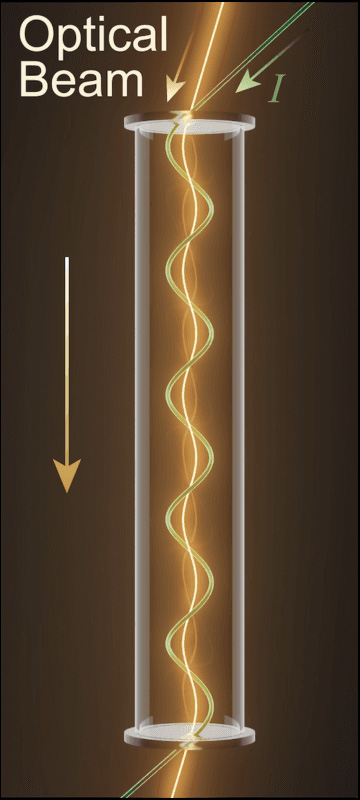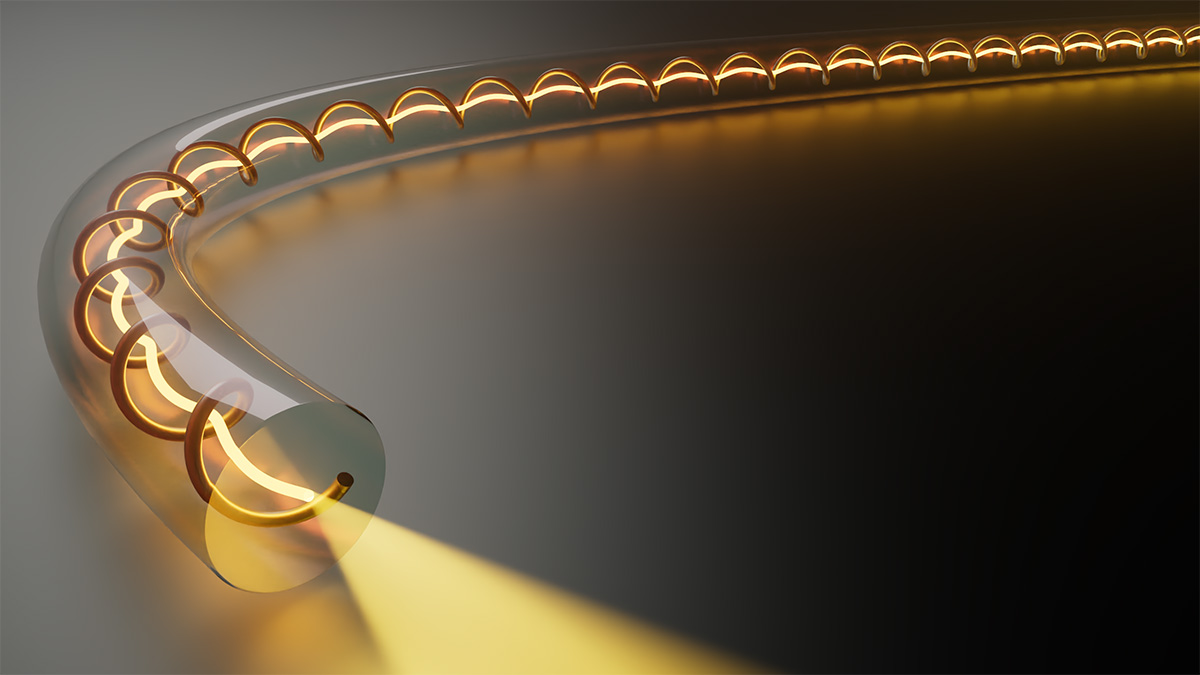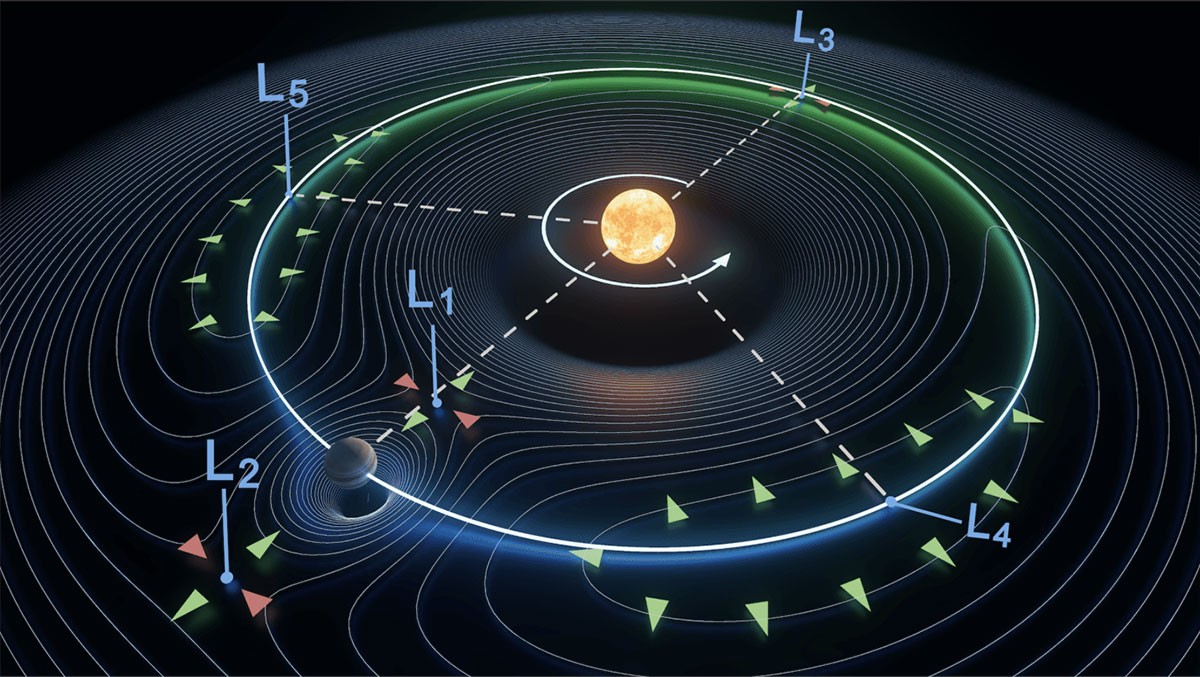An artist’s view of a "Trojan beam" guided through a transparent dielectric tube, via principles inspired by celestial mechanics. [Image: Courtesy of D. Christodoulides and M. Khajavikhan / USC]
Optical scientists and engineers have become masters at guiding light through all manner of materials. The most familiar (and world-changing) example is optical fiber, where light is shunted through a high-refractive-index core that’s surrounded by a low-refractive-index cladding, and hemmed in by the phenomenon of total internal reflection (TIR). But can light also be guided through a material—say, a transparent bulk dielectric—that lacks such a refractive-index contrast or other periodic structure to serve as a “control knob” for waveguiding?
Researchers at several US universities, led by Demetrios Christodoulides and Mercedeh Khajavikhan at the University of Southern California (USC), suggest that the answer is yes. And they’ve taken the inspiration for their solution from a surprising source: celestial mechanics.
In a set of elegantly simple experiments, the team has shown that by setting up, within a homogeneous dielectric medium, the optical equivalent of Lagrange points—the gravitationally neutral zones that form between massive astronomical objects in space—tightly guided laser light can flow through the material with only a trivial lateral spread (Nat. Phys., doi: 10.1038/s41567-023-02270-6). The team has dubbed these trapped, guided waves “Trojan beams,” in homage to the so-called Trojan asteroids that tend to pile up in two stable Lagrange points of the sun–Jupiter system.
In an email to OPN, Khajavikhan and Christodoulides described the Trojan-beam setup as “an altogether novel approach to trapping light”—one that they believe could prove handy in settings, such as liquids and gases, where conventional approaches to light guiding aren’t feasible. The idea could even find use, they suggest, in non-optical systems such as acoustic waves, electron beams and cold-atom waves.
Of Lagrange points and Coriolis forces
In celestial mechanics, Lagrange points form where the gravitational and centrifugal forces of two massive bodies—such as the sun and the Earth, or the sun and Jupiter—are in balance. The result is five gravitationally neutral zones in space.
The five Lagrange points of the sun–Jupiter system, with contour lines of graviatational potential. [Image: Y. Wei / USC Viterbi School of Engineering]
Three of those zones—rather un-poetically labeled L1, L2 and L3—are unstable, meaning that objects that find their way into orbit around the Lagrange point will eventually drift back out. Even so, several of these have proved convenient spots to park spacecraft for long-term observation of the cosmos. The James Webb Space Telescope, for example, orbits the L2 Lagrange point, on the far side of Earth. The Aditya L1 spacecraft of the Indian Space Research Organization, launched in September 2023, will eventually hang out at L1, between the sun and the Earth, for its studies of the solar atmosphere.
In thinking about guiding light, however, it was the other two Lagrange points—L4 and L5—that piqued the USC-led team’s interest. Each of these points sits at one of the vertices of an equilateral triangle with the two massive objects in the system (for example, the sun and Jupiter).
L4 and L5 are called stable Lagrange points, as objects captured in these gravitationally neutral zones tend to stay put. That’s because of another inertial force, the so-called Coriolis force, which—owing to the co-rotating reference frame of the system—tends to cause a moving object that starts to stray out of its Lagrange-point orbit to curve back in. It is the Coriolis force that traps the Trojan asteroids in the L4 and L5 points of the sun–Jupiter system.
An optical Coriolis force
Could an optical equivalent of the Coriolis force be used to trap and guide light without the benefit of total internal reflection? The team thought it might be possible.
Could an optical equivalent of the Coriolis force similarly be used to trap and guide light without the benefit of TIR? The USC-led team (which also included scientists from the University of Central Florida’s CREOL and Cornell University, NY) thought it might be possible. Specifically, the researchers reasoned that optical analogues of the Coriolis force might arise if a spirally varying distribution of heat—and, thus, of refractive index—were introduced into a transparent dielectric material. Such a spiral distribution could, for example, be achieved by running a spiral iron heating wire through a material with a large thermo-optic effect.
The team showed mathematically that the resulting spiraling “index potential” should cause optical Lagrange points to form along the either side of the wire, creating zones where optical attraction and repulsion are balanced. The twisted geometry of the system in essence would give rise to optical Coriolis forces that would keep a light beam confined in the Lagrange points as it propagated through the axis of the spiral heat distribution. The researchers used both ray dynamics and the paraxial wave equation to study in detail how light might be guided through these optical Lagrange points.
Lagrange points on the lab table
To demonstrate these ideas in action, the team embedded a 0.55-mm-diameter spiraling iron wire in the center axis of a 30-cm-long, 2.4-cm-wide glass tube containing cured polydimethylsiloxane (PDMS)—a transparent dielectric with a room-temperature refractive index of n = 1.46 and a large thermo-optic coefficient. They attached electrodes to either end of the iron wire, and positioned cameras at the side and end of the transparent cylinder.

Experimental setup used to observe optical Trojan bound states (bright yellow beam). A stable Lagrange point is established via the thermo-optic effect. [Image: Y. Wei / USC Viterbi School of Engineering]
The researchers then shone a laser beam with a spot-size radius of roughly 110 µm into one end of the glass tube, sending it through the axis of the iron wire. With the electrical current in the wire turned off, the beam, as expected, spread out in the dielectric medium, with the spot size expanding some 250% across the 30-cm tube, to around 385 µm. But when the electrical juice was turned on and the wire started heating, the beam quickly got its act together; the spot size at the tube’s end was a much slimmer 112 µm—a spread of only 2%.
The team attributed the behavior—nicely demonstrated in a short lab video—to the creation of a defocusing spiraling index potential in the material by the heated helical wire. That potential, in turn, leads to the formation of optical analogues of Lagrange points along the wire’s length. The twisted geometry, analogous to the rotation of massive bodies in an astronomical system, gives rise to optical Coriolis forces; these stabilize the Lagrange points and keep the light tightly trapped as it propagates along the axis of the system.
The researchers confirmed the source of the light guiding by measuring the Trojan beams’ phase distribution using a Mach-Zehnder interferometer; the distribution agreed well with the team’s theoretical calculations. Interestingly, the team also achieved a similar result with a DNA-like double-helix wire embedded in the cylinder.
Guiding waves in unpromising settings
The authors write in Nature Physics that the demonstrated approach can enable light guiding “even in defocusing environments at points where the refractive-index profile (within the stationary frame) is totally ordinary—with no features that could foretell a guiding behavior.” Christodoulides and Khajavikhan thus believe, as they noted in an email to OPN, that the use of Lagrange points and optical Coriolis forces could open up possibilities for guided light in otherwise unpromising settings.
In liquids and gases, for example, they observe that it’s difficult to introduce a waveguide structure and thus to channel light using conventional methods such as TIR. “The Trojan method completely overcomes these problems,” they suggest. The pair adds that the approach could potentially be useful in some high-power and communications systems where the creation of standard waveguides is similarly challenging.
Moreover, Khajavikhan and Christodoulides point out that, because “the wave equations in optics and acoustics are isomorphic,” an analogous strategy might be used to guide sound waves, or other wavelike systems such as electron beams or ultracold-atom systems. “It should also work in this domain,” they told OPN, “since the dynamics are at the end Newtonian.” The venerable wave equation, it would seem, still has some surprises in store.


